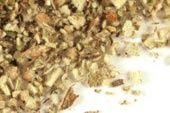Mullein Leaf
Mullein is a wayside pasture plant easily recognized by its large, gray-green, hairy leaves and tall flower spikes, rising from the ground almost like a stalk of corn.
The flowers were once used to produce yellow-green dye, while the leaves were used to insulate footwear and to make candle wicking. Because of the high mucilage content of the leaf, mullein is commonly still used today to make topical ointments, salves, and skin creams. Mullein leaf is also used to make herbal teas, syrups, and throat lozenges.
Mullein is a biennial herb with a very wide natural range that includes most of Europe, Africa, Asia and the Americas. Because the tall, fuzzy-textured leaves and yellow-blossomed central stalks are often found thriving where nothing else can, mullein has a reputation as an intrusive, weedy plant.
In Europe, there is a long history of use of mullein in herbal tonics and skin care formulas. The herb is an excellent choice for making syrups and throat lozenges due to its mucilage content.
